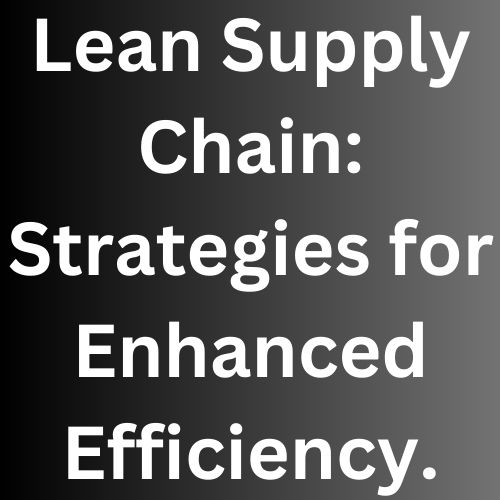
Lean Supply Chain
What is Lean Supply Chain?
Lean Supply Chain is used for enhancing overall performance or cutting down on stock and optimizing workflows which increases productivity and reduces waste. It can be used to boosts competitiveness or improve quality and lower expenses as it involves more responsive and nimble.
Principles of Lean Supply Chain
The principles of lean supply chain involves suppliers and partners with constant improvement and forging cooperation bonds which can boost productivity and the cut lead time processes is optimized. Inventory management are put into practice by storing less money and reducing superfluous inventory by getting rid of waste in every step. It also involves the use of standardize procedures and processes to increase quality and consistency with the help of data and analytics to make wise judgements. Every aspects is monitored and reviewed for continuously performance in order to make improvement by applying changes and authority to choose from through staff members.
History and Evolution of Lean Supply Chain
The history of lean supply chain was developed using the Toyota’s lean production techniques in the 1950s and 1960s to boost productivity or improve quality or strengthening supplier cooperation and cutting waste which are important tenets. It is used for the process of streamlining or inventory level minimization or lead time reduction and targets performance improvement which have an evolution impact for shifting consumer needs or globalization and technology. There are some strategies used such as the time inventory management or kanban systems and practices for continuous improvement which are frequently used for operational excellence or consumer happiness and for cost reduction.
Lean Supply Chain Benefits
Cost Reduction Strategies
The cost reduction strategies use inventory management Just-In-Time (JIT) to cut down on the expenses of extra holding and utilizing cross docking through expedite the flow of goods, storage of expenses and reducing handling. Through transportation it increases the effectiveness including route optimization and consolidation to work together with suppliers in order to obtain better pricing and terms. Projects are put into action for continuous improvement to help boost production and reduce waste with the use of supply chain management solution by investing in technology for better visibility control.
Increased Efficiency in Supply Chains
Increase efficiency in supply chains is used for cutting expenses to enhance client pleasure and it improves execution as a whole. It can be attained through the use of technology application or simpler procedures and improving stakeholder collaboration including adapting to changes in the market demands to help businesses stay competitive and reduces waste.
Lean Supply Chain and Sustainability
Lean supply chain and sustainability has two main goals which are cutting waste and enhancing corporate efficiency. It is used to achieve all of the following such as enhancing sustainability or reducing resource usage and streamlining procedures. Some of the advantages are financial savings or lower environmental impact and enhanced reputation. The use of lean concepts propels sustainability initiatives which is ecologically responsible business model for an effective result using the business models.
Improved Customer Satisfaction
Improve customer satisfaction for cutting down on wait times, customer correspondence is improved and customer input is incorporated by enhancing the process. It is also used for an easy and quick order fulfillment throughout the supplier chain to open relationships for trust of customers and gaining their loyalty. The metrics are tracked and continuously analyzed relating to the client satisfaction and superior merchandise of relentless provision.
Lean Supply Chain Implementation
Steps to Implement Lean Supply Chain
Make things more transparent or boost productivity or cut down on waste and improve rank and list areas. Create a map of the existing situation through resources or information and to identify the movement of materials using the SMART goals and objectives. The movement of materials and information are illustrated through making a value stream map and to detect waste and inefficiencies. It uses Just-In-Time inventory management for continuous improvement through the lean concepts of process standardization. The lean concepts should include instruction of employee education and instruments for process enhancement including problem solving strategies. The KPIs is used to measure and monitor progress for customer satisfaction or cost savings and track efficiency in order to maintain continuous improvement using update supply chain procedures.
Lean Supply Chain Planning and Execution
Lean supply chain planning and execution is used to concentrate on waste and get rid of inefficiencies to enhance performance and increases client happiness. It is use to make use of the available resources or streamlines processes and improve lead time to boosts productivity also promotes cost savings. The main purpose is for an on going development or reacts fast to fluctuations in demand and focus on data driven decision making teamwork.
Lean Supply Chain Tools and Techniques
The lean supply chain tools and techniques are used to raise client satisfaction or simplify chain procedures or streamline processes, or for efficiency and cut expenses. There are some tools that are used for the lean supply chain such as the continuous improvement initiatives or kaban systems or Just-In-Time inventory management or kaizen events and stream mapping.
Lean Supply Chain vs Traditional Supply Chain
The lean procedures is used to reduce waste in all activities which might not be given much priority unlike traditional supply chain methods. For cost cutting and efficiency are one of the main priority of a traditional supply chain while the lean supply chain focuses on satisfying customer needed and emphasis on delivering values. Lean is used to promote improvement and ongoing learning environment which could adhere to set procedures as opposed to traditional. Lean methodology is used in the market client demands and conditions which exhibits greater agility and flexibility. To increase the efficiency with stakeholder or clients and suppliers, leans depends on an effective cooperation and partnerships.
Advantages of Lean Supply Chain Over Traditional Methods
The lean supply chain benefits over traditional supply chain are, it is used to simplify process in inventories or materials and minimizing time through increased efficiency and simplification. The services and products offered are increased by improving the quality for loyalty and increases client happiness. It is used for a quick reaction time on variations in demand or shifts in the market and adaptation to unforeseen events. Efficiency improvements are increased as an outcome of waste elimination by increasing earnings and reducing manufacturing costs. It improved cooperation for confidence or transparency or enhancing dependability amongst stakeholders and promotes communications. It is used to attract environmentally conscious customers or enhancing brand recognition by lessen the negative effects on the environment.
Lean Supply Chain in Industry
Lean supply in industry uses the application of lean concepts through resources or information and optimizing the flow of materials. It is used to increase efficiency or boost customer value or cutting waste and lowering lead times. Feedbacks from clients continues to receive great acknowledgement for the quality or cost saving and competition.
Challenges in Lean Supply Chain
Common Lean Supply Chain Issues
Common lean supply chain issues are ineffective procedures, lack of visibility, unexpected disturbances and lack of departmental communication. Also they include an excessive amount of inventory, low levels of client satisfaction and lack of adaptability to shifting market conditions. It can result to shortages of certain products or higher expenses and longer lead times including adopting lean concepts and techniques for continuous improvement
Overcoming Lean Supply Chain Challenges
On a constant basis the supply chain should be streamline and enhanced also adopting an attitude of continual improvement to increase efficiency. Improve cooperation among suppliers and correspondence through tracking and enhancing visibility by utilizing technology. To solve some lean chain supply challenges involves making the process more simple by implementing an efficient inventory management.
Risk Management in Lean Supply Chain
The risk management in lean supply chain involves assessing the possible hazard and analysis of the supply chain impact. The supplier reliability must be taken into account also the demand unpredictability and transportation interruptions. It keeps a competitive edge or lower expenses and enhances durability as mitigating methods are put into practice.
Conclusion
Lean supply chain is used to boost productivity, save expenses and increases contentment among clients. It is used for focused work and consistent improvement is always needed to give a competitive edge. To improve significantly, the adoption of competitiveness and performance is always needed to eliminate waste.
READ MORE ON Lean Supply Chain
SEE MORE ON Startup Management: Importance, Growth, and Operations

